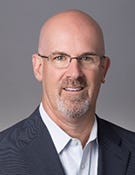Top Gun 51: What Makes a Next-Gen Channel Executive?
What’s driving our Top Gun 51 channel executives? The influencers who made the selections weigh in.
July 15, 2019

Cloud changes everything. What it took to be a great channel leader when most of our Top Gun 51 joined their current companies won’t get them – or their partners – to the next level. These execs are leading the flight away from an increasingly stagnant, traditional and transactional IT business model and linear supply chain to one that is persistent, fluid and non-transactional, at a velocity never before experienced.
Looking at it another way, if you can’t take the churn and burn, then maybe you don’t have the right stuff.

PartnerPath’s Diane Krakora
“We’re moving from focusing on landing the sale to technology/production adoption, usage, optimization and renewal,” said Diane Krakora, CEO of PartnerPath. “Yesterday’s channel leaders were sales managers focused on moving product — sell-in and sell-through. Tomorrow’s channel leaders need to inspire and facilitate a robust ecosystem of a variety of partners that put together complex solutions to address a customer’s business need or opportunity.”
The channel leader role historically has been defined by sales managers who were responsible for growing revenue through channel sales. Today, the sales role is just one of several that channel executives must balance. Here are some others: ultimate communicator, visionary, influencer within the organization, risk taker who is comfortable being uncomfortable, strategist over tactician, and leader capable of being agile and understanding the full customer cycle — just to name a few.
The channel leader who is a winner in the eyes of partners is all this — and someone who drives profit. After all, that’s always been the name of the game: How do I make money?
And therein lies the challenge for today’s channel executives. Partners look to you to be the early warning radar, but many any are late to the game because the cloud took them by surprise. And, the average tenure of a channel chief is only 18 months, says Anurag Agrawal, CEO and analyst at Techaisle, and a Top Gun 51 nominator.
We recently unveiled our “Top Gun 51,” today’s channel executives who deserve recognition for building and executing programs in a way that drives partner, customer and supplier success. |
It’s hard to make significant institutional changes or pivot a channel strategy in just a year-and-a-half. No wonder many channel leaders haven’t changed their approach to working with partners in this new era, and so partner programs evolve as an afterthought.

Techaisle’s Anurag Agrawal
“Ten, 15 years ago, things were different,” said Agrawal. “It was all about physical products — building faster servers, building new PCs, improving storage compression rates. And that fit neatly into existing partner programs. Next thing you know, 10 years goes by and now we have things being sold as a service and we’re in a post-transaction phase, and the partner channel teams don’t know how to take advantage of it and how they measure partner success.”
That’s because the vision and strategy at many vendor companies include input from the business unit leaders and the product leaders, but not the channel leaders.
“The channel leader is not in the boardroom, in most cases, and they need to be, because 75% of the world goes indirect,” said Jay McBain, principal analyst, global channels at Forrester, who also helped select our Top Guns. “Why? Because they don’t have the science to go compete for those dollars if they don’t know to a decimal point how much revenue the channel can drive.”
Agrawal agrees. “The CEO and the board must empower the partners and the partner chief a lot more than they’re doing now,” he said. “Unless they’re there, they won’t succeed.”
The distribution and master-agent executives who helped us select those Top Guns recognize this as well.
“Today’s channel chief is …
… an influencer within their organization and our industry,” said Kirk Robinson, U.S. chief country executive at Ingram Micro. “More often than not, a channel chief works across the organization – sales, marketing, product management, financing – to ensure that everyone is working together to do right by the partner.”
What stymies a channel leader?

Ingram Micro’s Kirk Robinson
“Working for a company that’s not channel-friendly,” said Robinson.
That’s not a problem that plagues our Top Guns. After all, prime time talent doesn’t stay where it’s not appreciated. But masters and disties see plenty of internal push and pull that doesn’t end up in the channel’s favor.
“If you have too little support and too few resources, you find yourself focusing more on executing and less on leading, which doesn’t allow you to be present and in front of your partners as often,” said Heather Murray, vice president, security and new vendor acquisition, at Tech Data.
Adam Knudsen, vice president of sales operations at TBI, agrees that channel executives are facing big challenges if they don’t have the company behind them to support and help execute on a new agile philosophy.
The Need for Speed
In what seems like the blink of an eye, the partner channel has shifted from a transactional, quick-sale model to one built on forming long-term customer relationships and understanding the goals and strategy of the end user. Here’s a dose of reality: Eighty percent of the 7,500 partners that Microsoft is bringing on monthly are non-transacting. Guess that’s why Top Gun Gavriella Schuster of Microsoft told partners the company “can’t afford” free internal user rights. (She reversed that decision on July 12.)
We recently unveiled our “Top Gun 51,” today’s channel executives who deserve recognition for building and executing programs in a way that drives partner, customer and supplier success. |
Similarly, Salesforce announced it needs to bring on 250,000 new partners to double its company — and, at the same time, shut down its resell program. That means that 100 percent of those new partners will be non-transactional partners.
The non-transacting side of the overall partner business is growing at 10-50 times the rate of traditional reseller programs, according to McBain. That means we’re seeing channel leaders set up dual tracks.

Forrester’s Jay McBain
“One will be resell-based, gold-silver-bronze, pyramid scheme-type of program, the one that’s been around for 37 years,” said McBain. “The smart ones are now creating a parallel program, which when you look at the 90 different things that go into a channel program, such as the onboarding, educating, training, the incentives, motivation, loyalty, co-selling, co-marketing … all of the motions are still there for the non-transacting partner, but the money doesn’t flow the same way.”
The growth of a non-transactional channel is leading to the rise of affiliate programs, advocate programs, influencer programs and alliances that lead to deeper, more meaningful and more lasting customer relationships.
“A great channel leader has the ability to [create dual channels] in parallel,” he said. “You can’t shut down your reseller channel, but you have to, in parallel, spread the focus to all different types of partnerships.”
In light of this disruption in the channel, agility is a critical trait.
“You have to be flexible enough to engage a wide variety of partner types in a programmatic and repeatable fashion,” said Krakora. “It’s a tug of war between flexibility and scalability in today’s and tomorrow’s channel leaders.”
PlanetOne founder and CEO Ted Schuman agrees. His master agency, for example, is seeing big growth with MSPs.
“The role of the channel chief has become …
… much more difficult because you’re managing so many aspects of the stack, not to mention the expectations around the customer experience are far more demanding,” said Schuman.

PlanetOne’s Ted Schuman
Channel executives who think what worked once will work again won’t survive.
“That’s a dangerous perspective that will stifle innovation,” said Jennifer Bodel, vice president of channels at Pax8. “A leader who is no longer learning, growing, collaborating and listening to peers, team members or partners — they’re on the path to failure.”
So, what do these keen observers suggest for those channel execs looking for a spot on the 2020 Top Gun 51? There’s no manual, but slicing through complexity is a great starting point.
Howard Huerta, vice president of channel sales enablement at Avant, looks at the pace of emerging technology just in the past two years and says that if you want to be a next-gen channel leader, you need the ability to turn the complex into something easily digestible by the channel.
“You also must stay relevant,” he said.
As for the best training ground for a next-gen channel chief?
“Work for an amazing channel leader that is changing the name of the game,” said Krakora. “Choose your next job based on who you’re working for, not the technology or market.”
We happen to have 51 channel leads who fit that profile. See who made the cut..
About the Author
You May Also Like


